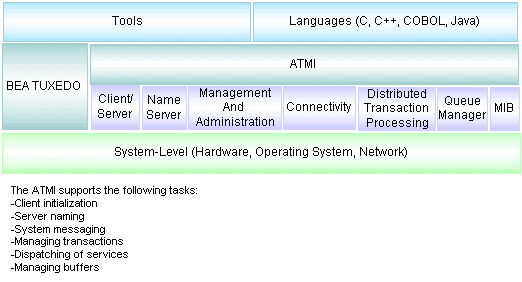


|

|
|
|
|
Development View: What You Can Do Using the ATMI
The Application to Transaction Monitor Interface (ATMI), the BEA Tuxedo API, provides an interface for communications, transactions, and management of data buffers that works in all environments supported by the BEA Tuxedo system. It defines the interface between application programs and the BEA Tuxedo system. The ATMI offers a simple interface for a comprehensive set of capabilities. It implements the X/Open DTP model of transaction processing.
Using the ATMI

The ATMI library offers you a variety of functions for defining and controlling global transactions in a BEA Tuxedo application. Global transactions enable you to manage exclusive units of work spanning multiple programs and resource managers in a distributed application. All the work in a single transaction is treated as a logical unit, so that if any one program cannot complete its task successfully, no work is performed by any programs in the transaction. Most ATMI functions support different communication styles. These functions knit together distributed programs by enabling them to exchange data. All ATMI functions send or receive data in typed buffers. Following is a list of ATMI functions (for C and COBOL bindings), grouped by the type of task they perform.
Using the ATMI Functions
Note: The use of ATMI transaction management functions is optional.
See Also

|

|

|
|
|
|
Copyright © 2000 BEA Systems, Inc. All rights reserved.
|